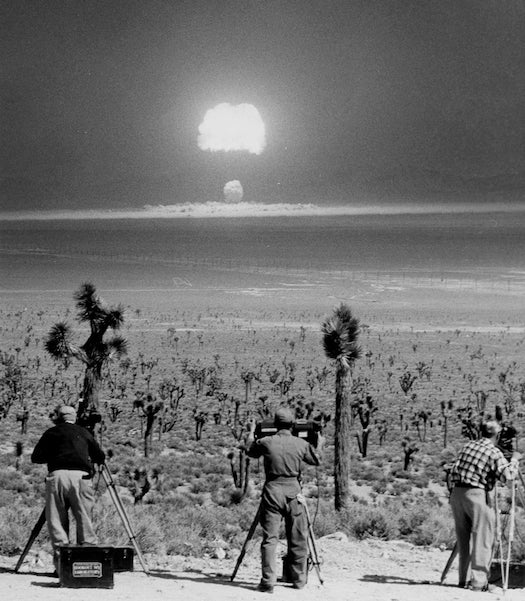Computer Models Show What Exactly Would Happen To Earth After A Nuclear War
Cheery happy times

You’ve seen what a nuclear winter looks like, as imagined by filmmakers and novelists. Now you can take a look at what scientists have to say. In a new study, a team of four U.S. atmospheric and environmental scientists modeled what would happen after a “limited, regional nuclear war.” To inexpert ears, the consequences sound pretty subtle—two or three degrees of global cooling, a nine percent reduction in yearly rainfall. Still, such changes could be enough to trigger crop failures and famines. After all, these would be cooler temperatures than the Earth has seen in 1,000 years.
Let’s take a detailed look at some of these super-fun conclusions, shall we?
First, what happened?
The team imagines 100 nuclear warheads, each about the size of the atomic bomb the U.S. dropped on Hiroshima, detonate over the Indian subcontinent. The team members are imagining an India-Pakistan nuclear war. It seems unfair to single out these nations, but I guess they’re the poster children because they have relatively small nuclear stockpiles compared to countries such as the U.S., Russia and China. The idea is, If these lightweights can do this to Earth, imagine what the bigwigs can do.
After the Indian-Pakistani nuclear exchange…
Five megatons of black carbon enter the atmosphere immediately. Black carbon comes from burned stuff and it absorbs heat from the sun before it can reach the Earth. Some black carbon does eventually falls back to Earth in rain.
After one year, the average surface temperature of the Earth falls by 1.1 kelvin, or about two degrees Fahrenheit. After five years, the Earth is, on average, three degrees colder than it used to be. Twenty years on, our home planet warms again to about one degree cooler than the average before the nuclear war.
Earth’s falling temperatures reduces the amount of rain the planet receives. Year five after the war, Earth will have 9 percent less rain than usual. Year 26 after the war, Earth gets 4.5 percent less rain than before the war.
In years 2-6 after the war, the frost-free growing season for crops is shortened by 10 to 40 days, depending on the region.
Chemical reactions in the atmosphere eat away Earth’s ozone layer, which protects Earth’s inhabitants from ultraviolet radiation. In the five years after the war, the ozone is 20 to 25 percent thinner, on average. Ten years on, the ozone layer has recovered so that it’s now 8 percent thinner.
The decreased UV protection may lead to more sunburns and skin cancers in people, as well as reduced plant growth and destabilized DNA in crops such as corn.
In a separate study, published in 2013, International Physicians for the Prevention of Nuclear War estimated 2 billion people would starve in the wake of a 100-A-bomb war.
Okay, I know I’ve just made your day with this list. Still, there’s a point to all this doom and gloom, the modelers write in their paper. The scientists want to motivate countries to destroy the estimated 17,000 nuclear weapons they still hold.
Will this work? Well, scientists and artists have been imagining the dire consequences of an atom-bomb war for decades. The very idea of a “nuclear winter” entered the popular imagination in 1983, when a study, authored by a team including Carl Sagan, first proposed that soot from fires after a nuclear war would block sunlight from reaching Earth.
Twenty-five years later, environmental scientists began using modern climate models to figure out what might happen after a nuclear war. Yep, these are the same models that scientists use to predict the effects of human-driven global warming. This new paper combined a number of those state-of-the-art models. If you check out the paper, published in the journal Earth’s Future, you can see how these conclusions compare to previous climate-model-based calculations. Different modeling efforts have come up with slightly different years for when the Earth would be coldest after a nuclear war, for example, but they generally agree that the effects would be, well, severe and long-term.